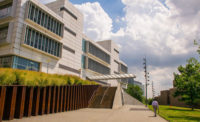In the Cause of Architecture
New Hotel for Global Nomads:
A review of the Exhibition at the Cooper-Hewitt National Design Museum

Nearby, there's an entire room devoted to the hideously decorated Burj Al-Arab Hotel in Dubai. The giant, graceful sail-like exterior is familiar to anyone who's picked up a travel magazine in the last few years. The interior is another story. Inside is an arrogance of color, shape and movement unseen since Napoleon's interior decorator shook off his gilded mortal coil. When leopard and other animal prints constitute the most conservative decorating motif, you know that something's gone horribly, terribly wrong. It's such an ostentatious display of misguided wealth that its only real purpose is to serve as a monument to hubris.
Which of course leads us to Vegas.
Albrecht commissioned photographer Richard Barnes to capture the ultimate hotel town in a series of photos called "The New Las Vegas." Vegas, with its false facades and commercialism is rife for over-explaining and paternalism by academics and designers, but Albrecht and Barnes avoided these missteps. Barnes' photographs instruct us that Vegas is the best incubator of the 21st century hotel. It's the ideal new hotel city: projects can go up, become occupied, get demolished and begun anew with a speed impossible in any other city. In Barnes' photos you can glimpse a half-dozen faux European cities spread across the Nevada horizon. In this examination more than any other in the exhibit you get a real sense of the global hotel industry at both its most democratic and most capitalistic.
There's a gallery devoted to the themes of Hotels on the Move and Natural Hotels that's entirely a thrill. Lewis.Tsurumaki.Lewis have created a hotel that extends the package tour experience vertically into the hotel room. Feeling moon-struck? Hans-Jurgen Rombaut's Lunatic Hotel gives you a room on the moon in a theoretical yet highly pragmatic project. ROY principal Lindy Roy's three ecological resort projects confront the trickier side of nature along with its beauty. The Wind River Lodge in Alaska is a starting off point for extreme skiers, Okavango Delta Spa in Botswana creates a sense of peace in a floating environment, and the Cancer Alley project in Louisiana somehow manages to make toxic pollution hip.
The successful commissioned works break down components or desires of a room into instructive and inventive packages. Tom Sachs' "Compact Full Feature Hotel Room" and M.K. Kähne's "Sanitary Furniture" package parts of the hotel experience. But of these new works Toland Grinnell's "Private Dancer" is the most exciting. The sleek, self-contained dance platform, sound system, mini-bar and primping station can be rolled into a room and out again with little fuss. With its black leather, platinum studs, brown satin, recessed lights, mirrors and brandy snifters for two "Dancer" emotes a packaged sensuality that the consumer goods it's sending up could only aspire to. More a promise of sex than the actual thing (a Victoria Secret catalogue, not a night with a lover), it's the perfect commentary on fashion as sex.
Another commissioned work is worth noting only for its failure to do, say or be anything. The wall notation for Dike Blair's "#1289, Seekonk, MA" tries to convince the visitor that it "subverts the homogeneity of American chain motels." Well, no it doesn't. Rather, it deftly exposes the banality of Dike Blair's gallery installations.
It's a disappointment that this and Diller + Scofidio's "Interclone" diversion are the only efforts the exhibit makes to address homogeneity, and that they take such a superficial (and unsuccessful) jab at chain operations. Although they couldn't cop to it, the modern boutique hotels and the designers creating their looks struggle with it just as much as Wyndham and Hilton. Two years ago it was wheat grass on every check-in desk and a Philippe Starck chair in every room. Now it's mismatched lumpy, anorexic and painful furniture in lobbies and pedestal sinks in every bathroom. The Rande Gerber–run bar and the CD library have become almost as ubiquitous as the continental breakfast. Whether you're checking into the Hudson in New York or the Clift in San Francisco you're guaranteed to be both charmed and frustrated by designers' "quirky" tricks (dangerously low lighting, fragile headboards). And you still can't go anywhere without tripping over something by Starck.
Standard, Hollywood, 1999, Shawn Hausman Photo © Tim Street-Porter. Courtesy André Balazs Even with their sins, considering all the energy the modern boutique hotels have infused the hotel industry with their presence in the exhibit is rather brief. A limited number of photos of André Balazs' built and unbuilt Standard hotels, Starwood's W hotels, and Ian Schrager's Clift, Sanderson and St. Martins Lane line walls on the first floor. Show underwriter Loews Hotel includes a rather modest number of tired press kit photos of their conversion of the International Style PSFS Building into the Loews Philadelphia Hotel.
What Albrecht and his fellow curators manage to do--especially with the mix of commissioned and exploratory works on the second-floor--is remind the visitor of the excitement of motion and ending up in a new place. In recent years hotels have again become as much a reason to travel as the cities in which they're located.


